
King Richard III: How a Man Becomes a Monster
History is notorious for being written by the victors, often to the detriment of truth. The losers are usually portrayed as small and insignificant to the course of history. However, such erasure can happen to the greatest and most influential people, even kings. King Richard III is perhaps one of the most infamous kings to wear the English crown. He has been depicted as a ruthless, power hungry villain by famous humanists such as Thomas More, and immortalized as a deformed monster by William Shakespeare. For over five hundred years, historians have commonly agreed with More’s and Shakespeare’s verdicts. It was not until recently that supporters of Richard took up the king’s case to truly examine the evidence against him. Some historians now see Richard, not as evil monster, but as man responding to a political crisis. Less clear, however, is the process by which the image of Richard III as England’s ‘Black Legend’ actually came into being. In this paper, I intend to trace the origin of that extremely negative assessment of both the man and his reign. My goal is to show how the image of the Duke of Gloucester as a monster is largely a literary construct.